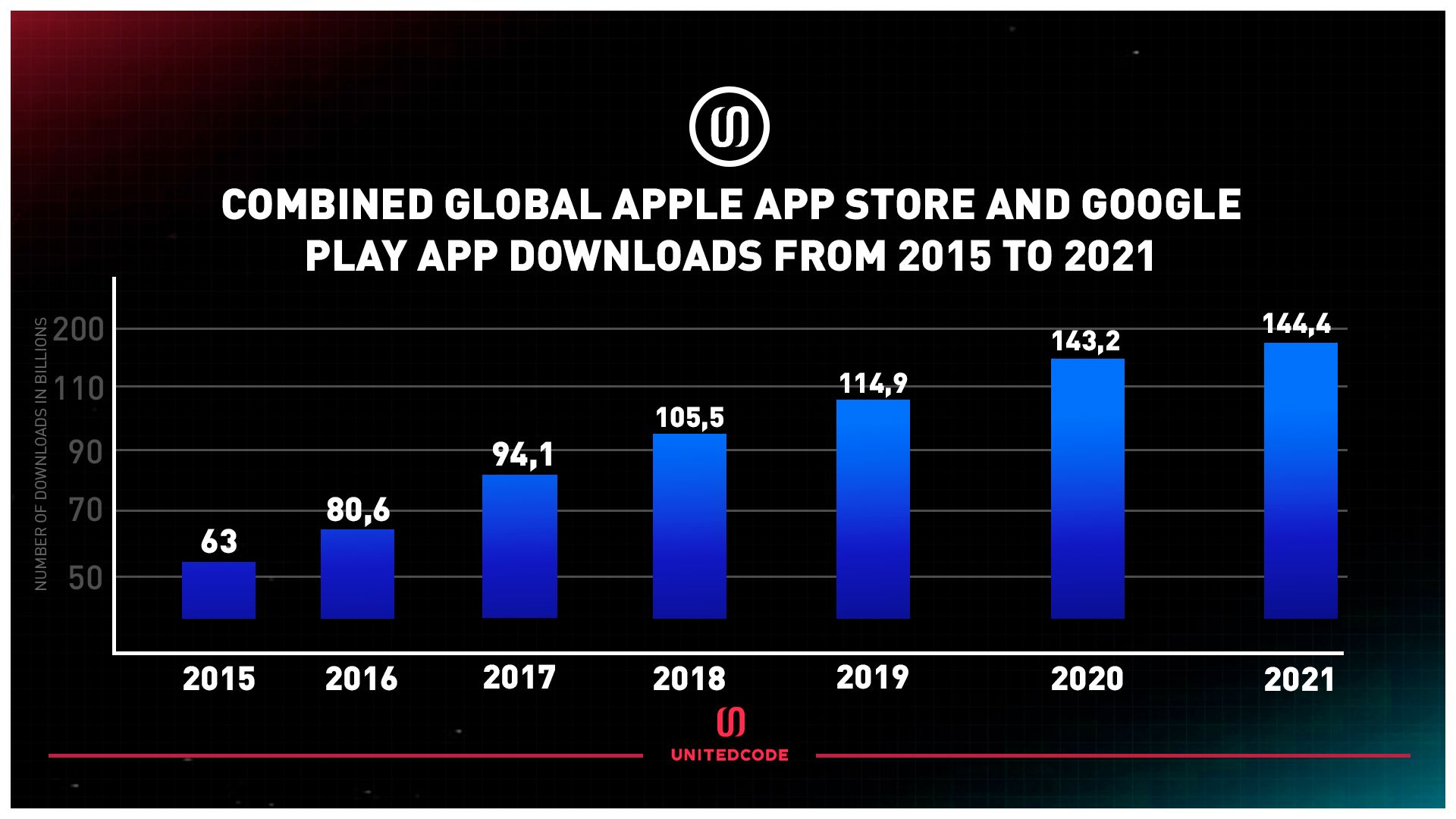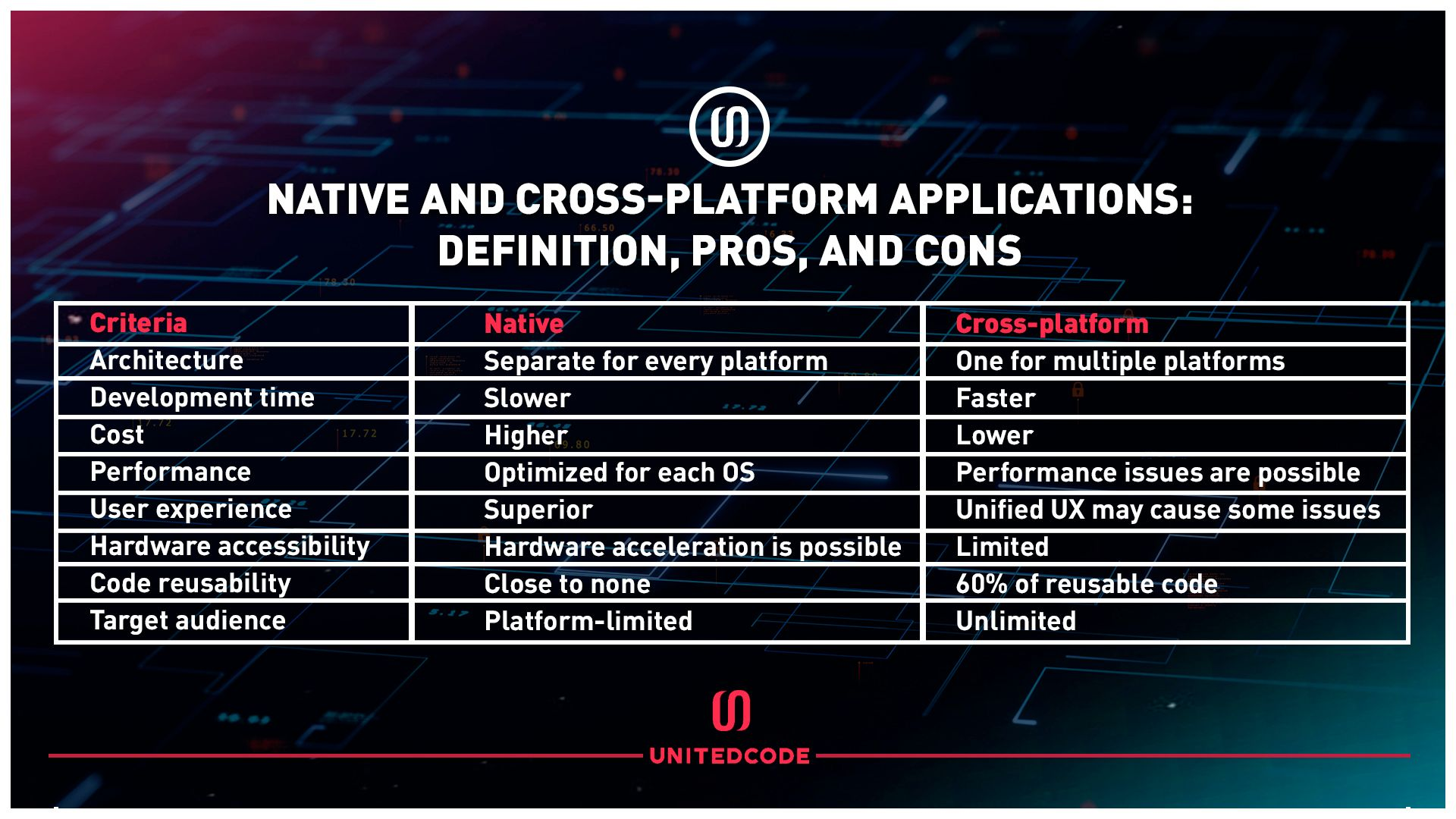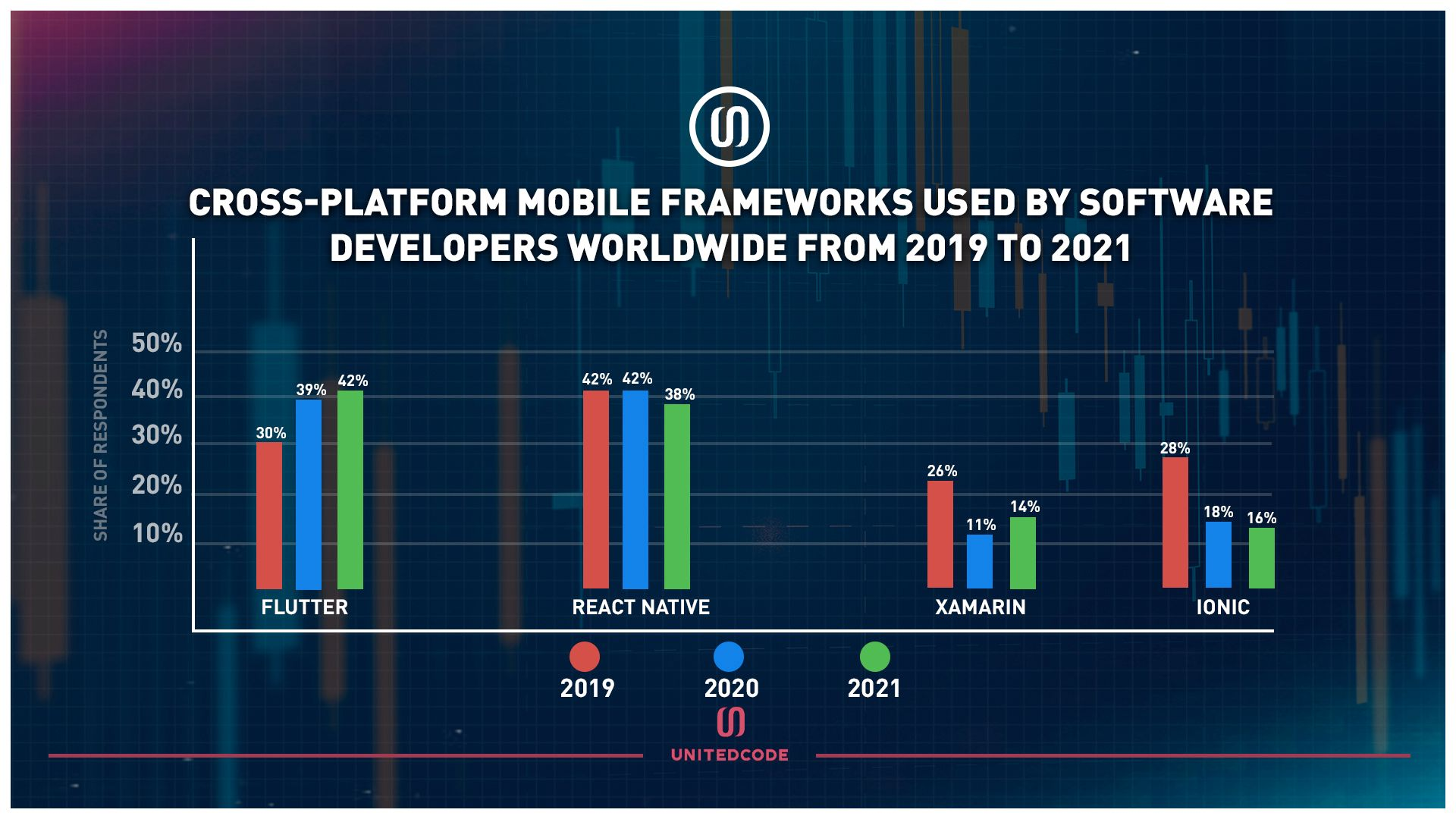According to Statista, the number of downloads on Google Play and the App Store has increased reaching 36.2 billion in Q4 2021. Apps are a necessity nowadays, nevertheless, there is always the question of whether to make an app for each platform separately (native) or one that works for all (cross-platform).

Source: Statista
If you choose native development, you will have to support at least two platforms separately. This can lead to difficulties from both the financial side as well as from development and further support aspect. For example, if you need to introduce a correction or an additional feature into the software, the native version will require twice as much time for debugging and updating, because we are dealing with two fundamentally different instances of code. This is a significant pain point for business, considering that QA and updates are integral parts of any development process.
A solution to this problem is the implementation of different development approaches with a single code base. For example, you can use the Progressive Web App (PWA) technology or stick to cross-platform app development. You may read more on PWA and its benefits here while in this article, we’ll analyze what cross-platform applications are, what is the difference between cross-platform and native software, why businesses need them, how to develop them, and how much do they cost.
Native and cross-platform applications: definition, pros, and cons

Table of differences between Native and Cross-platform application
Native development
In native development, specialists create a mobile application separately for each platform. Developers use the appropriate original languages (Swift for iOS, Kotlin for Android) and the tools of a particular operating system.
Pros
-
Flexible development. It helps implement almost any business requirement or idea without hardware or functionality restrictions. Developers make the most of the features of each operating system.
-
Higher performance. Native apps have the ability to use hardware acceleration i.e. to take advantage of the unique capabilities of the device at the hardware level. All this gives native applications advantages in the form of faster response time and less chance of crashes. This is especially true when using the device’s graphics chip, which is why almost all mobile games and graphics editors are native for each platform.
-
Supreme UI and UX. Apple and Google have certain design guidelines that prescribe the type of icons, controls, interface design, standard gestures, etc. Following these guidelines allows apps to be intuitive for users. Native development takes these points into account so that the application is developed in a way that is familiar to the users of a particular platform.
Cons
-
Increased time and budget. Developing a separate piece of software for each platform can significantly increase development time and with it the budget. This is due to the need to write two completely different codes and adapt the design for each platform separately. The cost of QA procedures, which sometimes takes up to 30% of the development budget, will also be higher since QA engineers will have to fix bugs for each platform separately.
-
A smaller user base. By developing a native app, you limit your target audience to a specific platform. For some regions, this can be critical.
An example of a well-known native application is Instagram. Meta’s decision to use a native development approach was due to the high load of the application. It uses the hardware acceleration of mobile devices to process a lot of different graphics and animations, as well as inbuilt graphic editors. The native approach in this case guarantees maximum performance and a seamless user experience.
Cross-platform mobile development
Cross-platform application development implies the creation of software for multiple platforms using just one piece of code. Such major market players as BMW, Alibaba, eBay, Google Pay, and Toyota already embraced the cross-platform development approach. The choice of these companies shows that the cross-platform development approach successfully copes with the challenges of the products.
Pros
-
Global user base. You can expand the user base by making the app appear in multiple stores simultaneously.
-
No talent shortage. One source code saves you the trouble of hiring multiple developers for each platform;
-
Increased development speed. For different projects, the launch time reduction rates will vary depending on the functionality of the application but on average, the time savings can be as high as 20%. This approach reduces time-to-market and allows you to start gaining profit faster.
-
Reusable code base. 60-75% of the code base of a cross-platform application can be reused and adapted for new projects.
-
Lower cost. The cost of fixing bugs and adding new functionality is reduced.
Cons
-
Less flexible functionality. Because of the difference in operating systems, the implementation of some functions will be difficult and the application may not work as smoothly.
-
Restrictive requirements. The application stores, particularly the AppStore, will have higher requirements for a cross-platform app, moderation will be longer, and other problems may arise.
-
Slower performance. Because of the difference in the interface of the operating systems, a cross-platform app is usually slower than a native app.
-
Problems with operating system updates. Cross-platform applications may lag behind in functionality as they cannot use all of the device’s capabilities.
Of course, users may not even notice the difference between native and cross-platform apps. Cross-platform software is designed in such a way that they are not visually or mechanically different from a native app.
Which companies need cross-platform development?
There is no single correct answer because it all depends on the business challenges, the complexity of the project, and individual circumstances. However, we can give some useful recommendations. For example, a cross-platform approach will suit your company more if:
-
The product is not yet widely known, user demand has not been formed and you need to quickly bring the MVP to market.
-
The market is formed, but the business wants to get ahead of the competition and implement a new feature, high-speed development on two platforms at once is important. You don’t need a lot of time for code writing and testing, and you can save resources.
-
You own a relatively small business and your development budget is limited.
-
You do not need a lot of features and functions such as geopositioning, access to the camera, etc.
-
you need a simple application for a specific task, e.g. a news feed or a voting form.
What to consider when choosing an approach to creating an app
Before answering this question, it is crucial to analyze your business. Consumer segments, the value of time and money resources, the desired depth of application integration with user devices, and clear long-term goals are the minimum on which your choice will depend.
- What does your audience use?
If you know that the ratio of iOS and Android users among your customers is close to a 50/50 split, a cross-platform app that allows you to get your product on both platforms at once may be better.
- How much time do you have for development?
The answer to this question determines the financial cost of the project. Of course, in terms of human resources spent on development (the number of hours and specialists, to put it simply), a cross-platform application seems to be a more profitable solution.
- What features does your project have?
Native apps are capable of playing heavy graphics quickly and without loss of quality. Today’s cross-platform solutions also allow for high performance in running the application, but on weak devices, the difference with a native solution can still be noticeable.
Cross-platform technologies and frameworks
So, you already know the benefits of cross-platform applications. Now it’s time to find out what technology stack you need to create this great software as well as get a glimpse of average developers’ rates in different regions.

Source: Statista
Flutter
The language itself is very similar to Java. Transitioning to it is not too difficult for experienced Android developers who know Kotlin and Java. The framework’s website has simple and straightforward documentation, so it’s realistic to get to grips with.
With Flutter, a single UI is created (using a declarative approach) for both platforms. And there will be no restrictions on customizing native UI components.
Pros
-
The Flutter team did their best to make the widgets indistinguishable from native components. In this way, you can get a great user experience from the app. And you won’t even think that the application was developed using any cross-platform framework.
-
Everything is widget paradigm that Flutter uses doesn’t have the usual division into conditional Activity and Fragment. All we see in front of us is a widget. We create other widgets by putting them together. This approach is considered scalable, powerful, and easy to understand.
Average developers’ rates per hour
-
USA: $58.97
-
Nearshore countries: $50
-
Offshore countries: $44.80
React Native
React Native uses Javascript or TypeScript to develop applications and translates React Native components into platform components.
Pros:
Large community.
Used by Skype, Discord, Shopify, Tesla, Artsy.
Native app features are available.
React Native was created to bring React to mobile technology. And it has worked out really well. According to Bitrise statistics, React Native has a 13% market share. It’s also used by over 500,000 repositories on GitHub.
Average developers’ rates per hour
- USA: $80
- Nearshore countries: $56.31
- Offshore countries: $45.41
Other important cross-platform development frameworks
Angular
A powerful and convenient tool for developing web applications. It is used by such giants as Google and YouTube.
Pros
- Angular helps you bind application components together, transfer data, animate interfaces, and more.
- Angular documentation contains a recommendations and style guide.
- Angular developers are Google employees, and the support of the big corporation helps the framework grow.
Average developers’ rates per hour
- USA: $62.50
- Nearshore countries: $53.73
- Offshore countries: $42.48
Vue
Vue offers an adaptable ecosystem that can scale between a library and a full-featured framework.
Pros
- Vue provides a quick transition period from other frameworks to Vue.js.
- Vue.js helps you develop fairly large, reusable templates.
- Allows you to achieve much higher performance.
Average developers’ rates per hour
- USA: $67.50
- Nearshore countries: $52
- Offshore countries: $42.69
React.js
This framework is great for creating huge web applications where data can change on a regular basis.
Pros
- Virtual DOM (document object model), allows you to arrange documents into a tree that best suits web browsers to analyze different elements of a web application.
- Combined with ES6/7, ReactJS can easily handle high workloads.
- Incredibly lightweight.
- Migration between versions is usually very easy.
Average developers’ rates per hour
USA:$66.67
Nearshore countries: $55.68
Offshore countries: $43.92
Xamarin
The framework is consonant with the name of the development company that was acquired in 2016 by Microsoft. It allows people who write in C# to enter mobile development. With the ability to combine cross-platform code with some of the native solutions when needed, the Xamarin project can provide a fully native user experience.
Pros
- Official support from Microsoft to this day is a coin to the merits of this solution.
- Due to its versatility, the development cost of getting the product to market and further support can be reduced by several times.
- There are built-in tools for testing. This will simplify the monotonous manual testing on each platform.
Average developers’ rates per hour
- USA: $67.50
- Onshore countries: $55
- Offshore countries: $30
Ionic
One of the most widely discussed frameworks. As the official website says, Ionic is an SDK for creating hybrid mobile applications, a set of CSS and JS components based on AngularJS, SASS, Apache Cordova. Drifty, whose product Ionic is based on, has already spent $3.7 million on Ionic, which demonstrates the potential of the tool.
Pros
- Support for other frameworks.
- Cross-platform.
- Plugin Support.
Average developers’ rates per hour
- USA: $48.72
- Onshore countries: $55
- Offshore countries: $30
The choice in favor of cross-platform or native development should be made based on a variety of conditions. Consider the goals and objectives of your business and the functionality you need. It is safer and more reliable to develop high-loaded large systems natively. Simpler projects can be safely implemented cross-platform. If before there were a lot of skeptics regarding the viability of this technology, time and market in which new frameworks have not just adapted, but gained popularity, only speak in favor of cross-platform.
The main thing to remember regardless of the approach, you need top-notch professionals. And UNITEDCODE will take care of all aspects of finding them. We provide a unique UNITEDCODE delivery service, during which we bring together teams of software developers from Eastern Europe and provide their services to you. In addition, we check the professional and communication skills of each engineer and help them to get into the project as efficiently as possible. Do not hesitate to contact us, because we work with a limited number of clients at a time.



